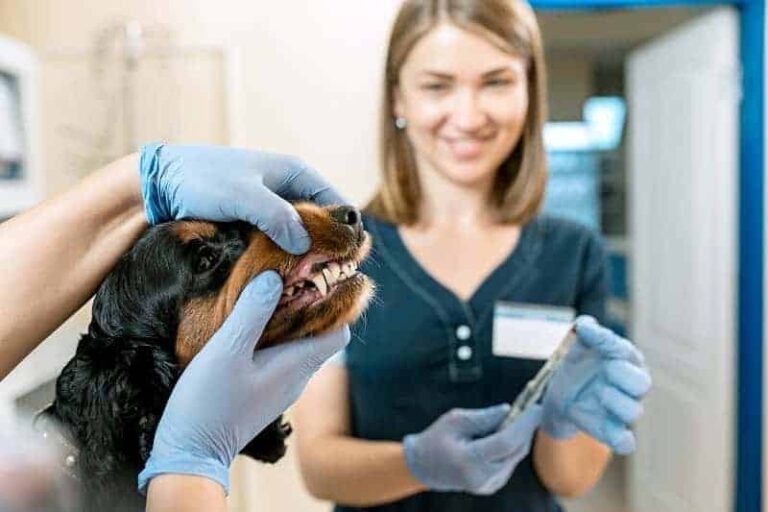How Pet Insurance Works (A Complete Beginner’s Guide)

Do you want to know how pet insurance works? Pet insurance is health insurance for your pet that works in a similar manner to health insurance for humans.
But in this case, the health care policy reimburses you for certain medical expenses.
There are procedures that most pet insurance companies require that you follow.
So, here are the things you’ll learn in this article:
- What is pet insurance?
- How does pet insurance work?
- What affects your pet insurance premiums
- What does pet insurance cover and not cover?
That said, let’s get into the details.

What Is Pet Insurance?
Pet insurance is a type of insurance coverage that helps you pay for your pet’s medical expenditures as well as unexpected illnesses and accidents.
It’s a type of health insurance policy that protects your pet and also prevents you from paying expensive vet costs.
Basically, what a pet insurance company does is reimburse you for the cost of the vet bill after paying.
The reimbursement is made either as a fixed dollar amount or as a percentage of the procedure or service cost, depending on the policy and insurer.
Typically, reimbursements range from 70% to 90% and you can take your pet to any veterinarian of your choosing, unlike managed healthcare for people.
That said, most pet insurance plans are for dogs and cats, and a few pet insurers offer coverage for other animals, like birds, reptiles, horses, and rabbits.
There are three types of Pet Insurance Plans you can choose From:
3 Best and Cheapest Pet Insurance Companies In Canada
1. Accidents-only Coverage:
This plan exclusively covers medical pet emergencies. For example, if your furry friend accidentally swallows something they weren’t supposed to or got hit by a car.
All you have to do is just file for a claim and get reimbursed after paying the vet bill.
Other types of emergencies include:
- Lacerations and abrasions
- Burn injuries
- Abnormal bloat
- Cruciate ligament tears
2. Accidents and Illness Coverage:
This kind of insurance typically pays vet bills for illnesses, including common illnesses, hereditary conditions, and serious illnesses.
It includes the cost of emergency vet visits together with standard veterinary care required to treat common health problems in pets.
For instance, diagnostic tests, lab work, physical examinations, and similar essential services such as:
- Biopsies, lab work, and other diagnostic tests
- Intradermal skin or RAST allergy testing
- MRIs, CT scans, X-rays, and ultrasounds
- Chronic conditions — epilepsy, diabetes, allergies, etc.
- Cancer treatment — radiation, stem-cell therapy, and chemotherapy
- Hospitalization and surgery
3. Pet Wellness Coverage
After selecting your desired level of coverage, you can then opt for a wellness program for pets, which will act as a “rider” on top of your insurance policy, if you choose to sign up.
Doing this will provide financial benefits on preventive care such as annual checkups, required for your pet.
- Vaccinations
- Flea/tick prevention
- Professional dental cleaning
- Spay/neuter surgery
- Fecal and routine blood tests
- Microchipping
- Grooming and nail trims
- Preventative dental care
- Medicated shampoos
- Gastropexy
- Hip dysplasia exams, radiographs, or other OFA testing
- Routine anal gland expression
- Wearable pet activity monitors
- Training
- Reiki, massage therapy, acupuncture
- Cremation or burial
Continue reading to find out how pet insurance really works.
Also, read about the 4 Best and Cheapest Pet Insurance in California.
Here’s How Pet Insurance Works
In most cases, pet insurance functions just like any other insurance plan.
Here are the details of how pet insurance works in most cases:
- Contact your preferred provider to make an appointment for your pet’s vet visit.
- Take your pet in for care
- At the end of the appointment, pay for the visit and any associated costs, or depending on the company you choose they can pay directly to your vet.
- But if not you can send your insurer a claim and an itemized copy of your bill. You can do this with some companies using an app or email.
- Wait for your insurance company to examine your claim and pay you back for covered expenses.
- Depending on how fast your insurer processes claims, this could take a few days to a few weeks or longer.
Now, your reimbursement is dependent on how your plan is structured, and here are the three main parts below.
Read also, the 4 Best and Cheapest Pet Insurance Companies in Texas
What Plans Does Pet Insurance Cover?
Pet insurance works mainly on a reimbursement basis.
What this means is that when you take your pet to the vet, upfront then file a claim for the reimbursement of eligible expenses.
The submitted claim has to be accompanied by an invoice and receipt of your payment to the pet insurance company.
1. Deductibles
The deductible is the amount of the vet bills that you are to pay before your pet insurance coverage starts.
For instance, an insurance company might give you options to choose from $250, $500, and $800 deductible.
It’s important to note that choosing a smaller deductible will increase the monthly cost of your policy.
So, the best advice: don’t choose a deductible that is too high or too low, stay on the average level.
2. Reimbursement Percentages
This reimbursement level is basically the amount your insurance company will reimburse you as well as the portion of the vet bill you must pay.
If for instance, you choose a 70% reimbursement level, you will be responsible for 30% of the vet cost.
Now, it’s important to note that choosing a lower reimbursement level will reduce your monthly cost but you will have to pay more vet bills.
3. Annual Maximum Coverage Limit
Some pet insurance companies have a certain annual coverage limit they can attain to a policy.
What this means is that they can only pay claims up to a certain amount in a year.
So, if you choose a $5000 coverage limit and you exceed this amount in a year, for the rest of the year you will pay the vet bills out of your pocket.
Although, there are some pet plans that offer unlimited coverage options.
Now you know about the plans, let’s see how your premium can be affected by some factors.
Top Pet Insurance Options for a Pet with Pre-existing Conditions
What Affects Your Pet Insurance Premiums?
There are factors that determine how much a pet insurance provider can give you for a monthly premium.
Here are the things that issuers will look at:
1. Your Pet’s Age:
Due to their higher risk of developing medical problems, older pets often cost more to insure than younger ones.
So early pet insurance can assist in keeping the costs down when the policy’s terms are renewed yearly.
2. The Type of Breed:
The cost of insurance for some dog or cat breeds that are more prone to illnesses might be way higher than other types.
For instance, the cost of insurance for golden retrievers is more than that of Yorkshire terriers or mixed breeds.
3. Location:
Basically, your zip code which shows your location actually plays a role too in increasing your quote.
So, it’s advisable you get quotes from insurance providers that are close to you based on your exact state.
4 Best and Cheapest Pet Insurance Companies In New York (NYC)
4. Plan Customization:
Many insurance providers actually offer different customization Ji so that you can only get to pay for what you need.
You can choose to lower your premium, by selecting a lower annual coverage as well as a lower reimbursement rate, and higher deductibles.
Although, having a higher out-of-pocket pay during a claim might cost a lot of money in the long run.
Continue reading to find out the thing that pet insurance covers and what it doesn’t cover.
What Does Pet Insurance Cover?
1. Accident or Illness Policy
As a matter of fact, whenever your pet dies, you can actually get back the cost of what you paid for it or the amount you can sell it.
However, some pet insurance companies have an age limit which they can pay for eight to eleven years for a cat and five to nine years for a dog.
After this year they will not pay or it might result in you making a contribution to costs.
In the case of illness, they also repay you for any cost you incur whenever your pet is I’ll up your annual coverage limit.
Below are some examples of the illness and common conditions that pet insurance companies cover:
- Cancer
- Digestive illnesses
- Chronic conditions
- Hereditary conditions
- Congenital conditions
- Dental illness
- Hip dysplasia
- Heart disease
- Diabetes
- Infections
What Does Pet Insurance Not Cover?
There are also some things that pet insurance companies do not cover regardless of the type of plan you paid for.
Here are some of the conditions and illnesses that pet insurance policies don’t cover:
1. Pre-existing illness or injury
This is a situation whereby your pet already had a medical condition prior to you taking an insurance policy.
These are chronic conditions like heart abnormalities or hip dysplasia that are seen as pre-existing conditions.
2. Waiting Period
Illnesses that start within the first 10 to 14 days of your pet insurance coverage are often not covered by most pet insurance providers.
There won’t be a “gap” in your coverage because some companies will waive this fee if you are transferring from another insurance.
3. Experimental treatment
These are diagnoses and therapies that are considered experimental, investigations or not up to the veterinary medical board of your state’s approved standards of practice.
That said here are some other conditions:
- Non-veterinary expenses.
- Issues related to breeding or pregnancy
- Food, dietary and nutritional supplements
- Grooming.
- Preventative care
- Spaying
- Neutering
- Non-veterinary expenses
- Routine and preventative treatment
- Elective procedures like ear clipping and tail docking
Conclusion
No one can predict the health like accidents or illness issues that might come up in your pet’s life.
But with pet insurance, you can at least have some control over the medical expense which gives you peace of mind.
Having pet health insurance is a very good asset for a pet parent and to benefit you financially you should choose a plan that will be easy for you to pay for.
Above all make sure you try and gather multiple free quotes before making a decision.
Frequently Asked Questions
What is pet insurance and how does it work?
Pet insurance is health insurance that protects the health of your pet. It covers part payment of the costs of treating unexpected injuries and illnesses, so you don’t have to worry as much about expensive vet bills.
How Do I use pet insurance?
After visiting your vet and paying the vet bill you can then submit a claim for reimbursement to your insurance provider. With some pet insurance companies, you either submit claims online, by phone, or by mail.
How Does A Pet Insurance Deductible Work?
A deductible is an amount of the vet bills that you are to pay before your pet insurance coverage starts. For instance, an insurance company might give you options to choose from $250, $500, and $800 deductible. So if you choose $500 you’ll have to pay this amount for vet costs each year before you can get reimbursed.
What Factors Affects The Cost Of Your Insurance Premium?
Firstly the age, breed, size, and location of your pup will affect the cost of your insurance. Secondly, the type of insurance plan and policy the company is offering also plays a major role. Finally, you’re the one to choose which plan and policy will work for you by selecting a quote that makes sense for your budget.
How Do you know which vet accepts pet insurance?
Basically, pet insurance companies don’t pay your veterinarian directly instead they reimburse you for the cost. After you must have paid your vet and submit a claim with a copy of your receipt to the insurance company. With this, you don’t have to worry about your vet accepting a particular policy or not so you can use any veterinarian of your choice.
How does pet insurance work Nationwide?
Most pet insurance policies are accepted by any veterinarian of your choosing. Your policy might, however, change if you choose to relocate to a different state due to local laws and other factors.
How long does it take pet insurance to start working?
How long does it take pet insurance to start working? There will be a waiting period after you buy insurance during which some coverage will be restricted. The pet insurance provider sets the waiting periods, so it’s important to inquire before enrolling. Most waiting periods take 14 to 15 days long.
Why Should I Get Pet Insurance?
Most pet owners get pet insurance because of the peace of mind that their pet will always get the medical care it needs should anything happen to them suddenly.
Does pet insurance cover spaying and neutering?
Generally, most pet insurance companies don’t cover Spaying and Neutering because it’s considered a predictive procedure. However, there’s a way pet providers offer coverage for spaying and neutering through a wellness plan. Check out this article about The 4 Best Pet Insurance For Spaying and Neutering.
Will Pet Insurance Cover Hip Dysplasia?
Many pet insurance companies cover hip dysplasia since it’s a hereditary condition. However, some policies may subject you to a waiting period before the coverage begins.
References
- Investopedia.com – How Does Pet Insurance Work?
- Valuepenguin.com – What Is Pet Insurance and How Does It Work?





